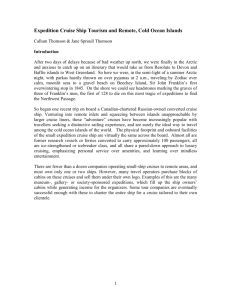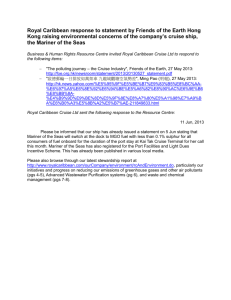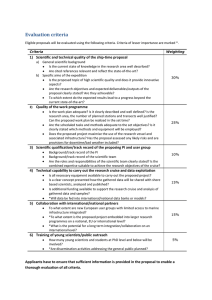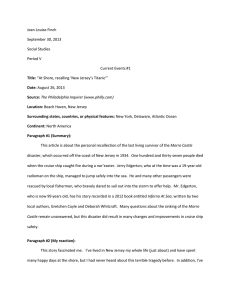A Novel Energy Management System for Cruise Ships Including Forecasting via LSTM
advertisement
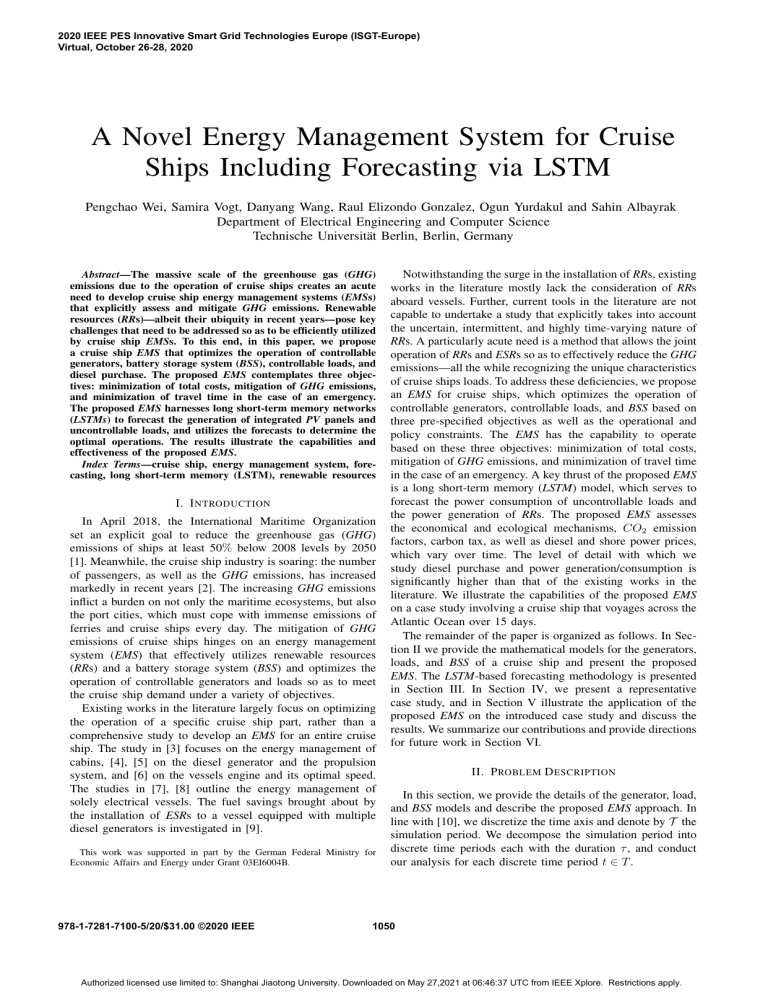
2020 IEEE PES Innovative Smart Grid Technologies Europe (ISGT-Europe)
Virtual, October 26-28, 2020
A Novel Energy Management System for Cruise
Ships Including Forecasting via LSTM
Pengchao Wei, Samira Vogt, Danyang Wang, Raul Elizondo Gonzalez, Ogun Yurdakul and Sahin Albayrak
Department of Electrical Engineering and Computer Science
Technische Universität Berlin, Berlin, Germany
Abstract—The massive scale of the greenhouse gas (GHG)
emissions due to the operation of cruise ships creates an acute
need to develop cruise ship energy management systems (EMSs)
that explicitly assess and mitigate GHG emissions. Renewable
resources (RRs)—albeit their ubiquity in recent years—pose key
challenges that need to be addressed so as to be efficiently utilized
by cruise ship EMSs. To this end, in this paper, we propose
a cruise ship EMS that optimizes the operation of controllable
generators, battery storage system (BSS), controllable loads, and
diesel purchase. The proposed EMS contemplates three objectives: minimization of total costs, mitigation of GHG emissions,
and minimization of travel time in the case of an emergency.
The proposed EMS harnesses long short-term memory networks
(LSTMs) to forecast the generation of integrated PV panels and
uncontrollable loads, and utilizes the forecasts to determine the
optimal operations. The results illustrate the capabilities and
effectiveness of the proposed EMS.
Index Terms—cruise ship, energy management system, forecasting, long short-term memory (LSTM), renewable resources
I. I NTRODUCTION
In April 2018, the International Maritime Organization
set an explicit goal to reduce the greenhouse gas (GHG)
emissions of ships at least 50% below 2008 levels by 2050
[1]. Meanwhile, the cruise ship industry is soaring: the number
of passengers, as well as the GHG emissions, has increased
markedly in recent years [2]. The increasing GHG emissions
inflict a burden on not only the maritime ecosystems, but also
the port cities, which must cope with immense emissions of
ferries and cruise ships every day. The mitigation of GHG
emissions of cruise ships hinges on an energy management
system (EMS) that effectively utilizes renewable resources
(RRs) and a battery storage system (BSS) and optimizes the
operation of controllable generators and loads so as to meet
the cruise ship demand under a variety of objectives.
Existing works in the literature largely focus on optimizing
the operation of a specific cruise ship part, rather than a
comprehensive study to develop an EMS for an entire cruise
ship. The study in [3] focuses on the energy management of
cabins, [4], [5] on the diesel generator and the propulsion
system, and [6] on the vessels engine and its optimal speed.
The studies in [7], [8] outline the energy management of
solely electrical vessels. The fuel savings brought about by
the installation of ESRs to a vessel equipped with multiple
diesel generators is investigated in [9].
This work was supported in part by the German Federal Ministry for
Economic Affairs and Energy under Grant 03EI6004B.
978-1-7281-7100-5/20/$31.00 ©2020 IEEE
Notwithstanding the surge in the installation of RRs, existing
works in the literature mostly lack the consideration of RRs
aboard vessels. Further, current tools in the literature are not
capable to undertake a study that explicitly takes into account
the uncertain, intermittent, and highly time-varying nature of
RRs. A particularly acute need is a method that allows the joint
operation of RRs and ESRs so as to effectively reduce the GHG
emissions—all the while recognizing the unique characteristics
of cruise ships loads. To address these deficiencies, we propose
an EMS for cruise ships, which optimizes the operation of
controllable generators, controllable loads, and BSS based on
three pre-specified objectives as well as the operational and
policy constraints. The EMS has the capability to operate
based on these three objectives: minimization of total costs,
mitigation of GHG emissions, and minimization of travel time
in the case of an emergency. A key thrust of the proposed EMS
is a long short-term memory (LSTM) model, which serves to
forecast the power consumption of uncontrollable loads and
the power generation of RRs. The proposed EMS assesses
the economical and ecological mechanisms, CO2 emission
factors, carbon tax, as well as diesel and shore power prices,
which vary over time. The level of detail with which we
study diesel purchase and power generation/consumption is
significantly higher than that of the existing works in the
literature. We illustrate the capabilities of the proposed EMS
on a case study involving a cruise ship that voyages across the
Atlantic Ocean over 15 days.
The remainder of the paper is organized as follows. In Section II we provide the mathematical models for the generators,
loads, and BSS of a cruise ship and present the proposed
EMS. The LSTM-based forecasting methodology is presented
in Section III. In Section IV, we present a representative
case study, and in Section V illustrate the application of the
proposed EMS on the introduced case study and discuss the
results. We summarize our contributions and provide directions
for future work in Section VI.
II. P ROBLEM D ESCRIPTION
In this section, we provide the details of the generator, load,
and BSS models and describe the proposed EMS approach. In
line with [10], we discretize the time axis and denote by T the
simulation period. We decompose the simulation period into
discrete time periods each with the duration τ , and conduct
our analysis for each discrete time period t ∈ T .
1050
Authorized licensed use limited to: Shanghai Jiaotong University. Downloaded on May 27,2021 at 06:46:37 UTC from IEEE Xplore. Restrictions apply.
Fig. 1. Diagram of the shipboard electric power system
Fig. 1 depicts a general electrical system of a cruise ship,
which includes a set of diesel generators d ∈ D, a set of
wind turbines w ∈ W as well as of PV panels s ∈ S
as generators g ∈ G. The maximum power limit for each
generator • is denoted by pmax
. In addition, shore power
•
pi may be purchased from the grid, when the cruise ship is
docking in one of the ports of the defined set i ∈ I.
X
X
X
X
X
pg (t) =
pw (t) +
ps (t) +
pd (t) +
xi pi (t)
g∈G
w∈W
s∈S
d∈D
tions, the proposed EMS is designed to operate based on three
objectives. Equations (1)-(5) represent the general constraints
in the three scenarios. Besides, the power of each diesel
generator, PV panel, wind turbine and BSS is also limited by
their corresponding minimum and maximum value. The power
and energy purchased from the grid at port are also finite.
• Economical scenario 1: Using a fixed velocity and time
schedule, the total costs must be minimized with an
optimal purchase plan of marine fuel and shore power
at different ports i ∈ I. These costs include the costs of
the energy sources • i.e. diesel and shore power purchase
at price λ• , the CO2 tax rco2 and the battery stress β.
t
; the amount of
The shore energy is defined as pi (t) 1h
diesel (in tonnes (t)) purchased in port i is denoted by
d(i). Further Eco2 denotes the total CO2 emissions during
the voyage. The constraints applied in this scenario are
the same as the above general constraints.
XX
t
(6)
min c =
λd (t)d(i) + λi (t)pi (t)
1h
t∈T i∈I
X
+β
pb (t)2 + rco2 Eco2
b∈B
•
i∈I
(1)
The binary variable xi indicates, if the cruise ship is in a
port. We consider that all battery units b ∈ B in the cruise
ship are lumped together under the term and collectively
referred to as BSS, which is used to store the electrical energy
from shoreside grid and the generators aboard. We denote
by pb the total net power provided or obtained by the BSS
the maximum power with which the BSS can
and by pmax
b
be charged/discharged. eb (t) is the energy stored in BSS at
time snapshot t, depending on the charging and discharging
efficiency η, the time step duration τ :
eb (t + 1) = eb (t) − η(pb (t))τ pb (t)
emin
b
≤ eb (t) ≤
emax
b
t∈T i∈I
•
(2)
(3)
The cruise ships power consumption is divided into the propulsion load, defined by pm and the hotel load ph . The propulsion
power is directly related to the velocity of the cruise ship u(t)
and a constant k as:
3
pm (t) = ku(t)
g∈G
b∈B
`∈L
To be able to meet the user’s preference under various condi-
Emergency scenario 3: In case of an emergency at
a random chosen point during the cruise, this scenario
provides the fastest way to the nearest port by maximizing
the propulsion power. Parts of the loads are reduced in
order to use maximum power for propulsion. Besides
general constraints, the vessel velocity in this scenario
is limited between umin and umax . The velocity change
between two time snapshots is limited.
X
X
X
p` (t) (8)
max pm (t) =
pg (t) +
pb −
pg (t),pb (t)
(4)
Added to this is a specific load from maneuvering while
arriving and leaving the ports. The hotel load ph describes
all loads which are not part of the propulsion. The generated
power pg and the net injected power of the BSS pb must be
equal to the total load power p` at all times to ensure the
power balance of the cruise ship:
X
X
X
pg (t) +
pb (t) =
p` (t)
(5)
Ecological scenario 2: In the ecological scenario the
objective is to minimize the CO2 emissions Eco2 of the
total cruise with an optimal purchase plan and optimal
usage of the BSS and energy generators on board. The
velocity and time schedule is fixed. We denote ε•co2 as the
specific CO2 emissions of the energy source •. Undesired
fluctuations in the BSS are attenuated by adding a battery
stress constraint. Other constraints applied in this scenario
are the same as the above general constraints.
XX
t
(7)
min Eco2 =
εdco2 d(i) + εico2 pi (t)
1h
g∈G
b∈B
`∈L\pr
III. U NCERTAINTY R EPRESENTATION
The mathematical models presented in Section II contain
uncertain data, such power consumption of the hotel loads
and power generation from RRs. These are forecasted using
an LSTM model.An LSTM unit contains an input gate, forget
gate, output gate and cell state. For all gates, the sigmoid
activation function is used. After the input gate, the previous
hidden state and input information will be in range [0,1], which
indicates the importance of information. The forget gate decide
if information should be preserved in the cell or forgotten. The
1051
Authorized licensed use limited to: Shanghai Jiaotong University. Downloaded on May 27,2021 at 06:46:37 UTC from IEEE Xplore. Restrictions apply.
output gate establishes the next hidden state. LSTM units are
stacked together to construct a LSTM layer.
In our work, a standard LSTM is used to accurately forecast
power generation of uncontrollable sources and power consumption of the hotel load for single or multiple time steps in
the future based on historical data. At the moment there are M
values of RR power generation measurements available, which
can be formulated as:
y = (y0 , y1 , ..., yM −1 )
(9)
where, yt is the actual RR power generation or power consumption of the hotel load for time step t. The power generation of RR and power consumption of the hotel load for the
following N steps will be predicted:
ŷ = (ŷM , ŷM +1 , ..., ŷM +N −1 )
(10)
TABLE II
P OWER AND CAPACITY OF ENERGY SOURCES
Energy sources
Diesel generator
PV panels
Wind turbines
BSS power
BSS capacity
[M W ]
[M W ]
[M W ]
[M W ]
[M W h]
maximum power/capacity
21.6
2.038
0.6
14
5.376
and water system. Additionally the subcategory base load includes all remaining loads, e.g. navigation and communication
system, sewage treatment and auxiliary machinery, which are
not part of the above mentioned categories.
where ŷt is the predicted value for time step t.
IV. C ASE S TUDY
The cruise ship Norwegian Star serves as a template for
the proposed EMS. She contains 1670 cabins and various
entertainment facilities such as 15 restaurants, 10 bars, a pool
and a spa. The maximum velocity is umax (t) = 25 knots.
We consider a transatlantic cruise from Barcelona to Miami
in July, which has a range of 4708 nautical miles (nm)
and is scheduled to take T = 15 days. We decompose
the cruise range into 95 distance intervals and adopt a time
resolution of τ = 15 minutes (min). Over its voyage, the cruise
ship docks at seven ports I = {Barcelona, Palma, Malaga,
Cadiz, Funchal, Ponta Delgada, Miami}. It is assumed that the
purchase of diesel and shore power is possible in all mainland
ports but not in the two island ports, viz.: Funchal and
Ponta Delgada. Additionally, shore power can be purchased
at the Spanish industrial electricity prices, which vary based
on the spot market [11] [12]. The Spanish carbon tax of
rco2 = 15.27 Euro/tCO2 e [13] is considered in the costs of
CO2 emissions. The specific CO2 emissions associated with
shore power εico2 are calculated based on the resource mix of
the Spanish electricity grid [14].
Fig. 2. Energy share of different load types
The forecasting analysis utilizes two main data sets: The
electric consumption of the Balearic island Formentera [18]
represents the hotel load of the cruise ship, since it has an
average power consumption of 12.5 M W , which is the hotel
load average [19]. The aggregated generation in June and July
2018 of PV panels in 19 houses in Austin, Texas from [20] is
scaled in order to match with the capacity of the installed PV
panels of 2.038 M W on the cruise ship.
V. R ESULTS
A. Forecasting Results
The PV generation dataset includes 45 days of historical
data. 30 days are used to train the LSTM network, while the
last 15 days are utilized for performance measurements. The
power consumption data of Formentera island was used to
predict the power consumption of the hotel load in the cruise
ship. Said division into training and test data was also applied
to the PV data.
TABLE I
S PECIFIC CO2 EMISSIONS εco2
Energy source
Diesel
Shore Power
kgCO2 e/kW h
0.5546 [15], [16]
0.237 [14]
Fig. 3. LSTM Network Structure
Based on the data of actual cruise ships, Table II summarizes
the maximum power and energy capacity of the energy sources
diesel and shore power. The cruise ship is equipped with ten
wind turbines and one diesel generator. During the cruise, the
instant power data of the wind turbines is obtained based on an
online simulator [17] and the instant power of the PV panels
is part of the forecasting results.
The hotel load of the cruise ship contains different subcategories, namely entertainment areas, public areas, private rooms
In order to predict the uncontrollable generation and load,
a standard LSTM neural network with two LSTM layers, two
dropout layers and one dense layer is constructed, as illustrated
in Fig. 3. Since the time resolution of the dataset is 15 min,
the input 96 historical data points i.e. last 24 (h) and current
time snapshot f(n), evaluated from the control system, are used
for forecasting the power generation or power consumption
in the next 24 (h). Although the LSTM neural network is
capable of retaining the memory of time series, we still provide
the network real data of uncontrollable source generation and
power consumption in order to correct the bias and predict
1052
Authorized licensed use limited to: Shanghai Jiaotong University. Downloaded on May 27,2021 at 06:46:37 UTC from IEEE Xplore. Restrictions apply.
the uncontrollable power consumption and generation more
accurately. All the forecasting numeric results are then used
for optimization. The forecasting result indicates that the PV
panels generate 2.27%, the wind turbines 1.28% and the diesel
generator and shore power 96.45% of the total generated
energy.
In the training phase, the mean squared error (MSE) loss
function is used, because MSE is able to penalize large prediction errors, which makes the predicted curve fit the actual
data better. The rectified linear unit (ReLU) activation function
is used in the dense layer. Adam optimizer is employed
during the minimization process. For the forecasting of the PV
generation, a good result is achieved when the dropout rates
are 0.5 and 0.2 respectively and 130 epochs with mini batch
size 8. Root mean square error (RMSE) and mean absolute
error (MAE) are used to measure the performance of the
trained model. A dropout rate of 0.3 and 130 epochs with
a mini batch size of 16 yielded the best forecasting results of
the hotel load data.
TABLE III
PERFORMANCE MEASUREMENT OF FORECASTING MODEL
Forecasting
Metrics
Train
Test
PV Generation
RMSE
MAE
6.58kW
3.38kW
10.32kW 4.86kW
Hotel Load Consumption
RMSE
MAE
0.31MW
0.24MW
0.84MW
0.71MW
B. Optimization results
The optimization problems are solved using Gurobi taking
predicted data for the hotel load and PV power generation
as input. As indicated in Table IV, the economical scenario
results in lower costs and the ecological scenario in lower CO2
emissions. In scenario 2 more shore power is used compared
to scenario 1, which leads to higher costs, but 100 tCO2 e less
CO2 emissions and hence lower carbon tax costs.
TABLE IV
OPTIMIZATION RESULTS OF SCENARIO
Scenario
c
cd
ci
rco2
E co2
E co2 d
E co2 i
[euro]
[%]
[%]
[%]
[tCO2 e]
[%]
[%]
1
501 838
90.87
0.68
8.45
2 776.9
99.65
0.35
1 AND 2
Fig. 4. Diesel and shore power purchase at different ports
The optimization was run with different variations from
50% to 150% of the previous used BSS and PV generation
capacity to evaluate the effect on both the difference of costs
and CO2 emissions, as indicated in Fig. 5. The maximum
generation capacity of the PV panels is only 10% of the peak
load, hence the effect of increasing or decreasing the installed
capacity is not very high. However a trend of decreasing costs
and CO2 emissions with rising PV capacity can be obtained.
A higher influence, on the other hand, can be observed from
a change of BSS capacity. Both optimization variables, costs
and CO2 emissions, reach their optimal minimum value with
the maximum BSS capacity. Therefore it can be concluded,
that a higher installed capacity of PV panels leads to more
independence from the conventional energy sources diesel and
shore power. This advantage becomes even more relevant the
more flexibility in time of energy demand is given with the
help of BSS capacities.
In the emergency scenario a randomly emergency time was
chosen, in this case on July 12, 2019; the nearest port is
Miami. As a result of the maximised velocity, the cruise
ship arrives to the final destination 11 h earlier. Table V
derives the comparison of the parameters between normal and
emergency operation. The velocity is higher than in the ecological or economical scenario, as expected. The daily energy
consumption is increased under emergency conditions in order
to increase the power of the propulsion pm . From Fig. 6 can
TABLE V
C OMPARED RESULTS OF SCENARIO 3
2
504 233
84.15
7.74
8.11
2 676.4
96.24
3.76
Scenarios
Avg. velocity u
Daily Energy
Avg. pm
Daily avg. ph
Fig. 4 describes the optimal purchase plan in the economical
and ecological scenario. It can be obtained that in both
scenarios, the majority of necessary diesel is purchased in
Cadiz, when the price is at its minimum. In the ecological
scenario, shore power is purchased whenever possible. An
interesting finding is that as many running loads as possible are
met by the supply of shore power during the docking including
charging of the BSS. Hence the amount of energy from shore
power is higher the longer the cruise ship stays at the port.
[knots]
[kW h]
[kW ]
[kW h]
1 and 2
17.6
422 144.9
7 222
281
3
21.27
452 808
11 724
276
Fig. 5. Costs and CO2 emissions with variation of BSS and PV capacity
1053
Authorized licensed use limited to: Shanghai Jiaotong University. Downloaded on May 27,2021 at 06:46:37 UTC from IEEE Xplore. Restrictions apply.
Fig. 6. Loads before and after the emergency (scenario 3)
be perceived that the propulsion load increased significantly
after the emergency. It has been determined that energy can
be saved in the cabins and entertainment areas in the event of
an emergency. Therefore, the cabin and entertainment loads
were reduced to 50% by switching off certain systems. The
maximum velocity that can be achieved will be directly related
to the maximum generating capacity of the diesel generator,
as well as the maximum velocity that can be delivered from
the propulsion system.
VI. C ONCLUSION
In this paper we propose a comprehensive methodology for
energy management analysis of a transatlantic cruise ship,
incorporating load and generation forecasting via LSTM as
well as the optimization of BSS usage and fuel purchase combined with the benefit of RR. Estimating realistic dimensions
of different loads in a cruise ship posed a challenge for this
research. With a better insight into all kinds of different loads
contained in a cruise ship as well as real historical data, the
model could be refined. In addition, these information could be
used to identify flexible and controllable loads, which can be
taken into account in energy management. The predicted load
can be achieved by a division into smaller subload categories
rather than an aggregated hotel load. Further improvements
in the forecasting of the RR generation can be achieved by
including additional features such as sunrise and sunset hours
depending on the location of the cruise ship or air temperature
to the LSTM model. A wider variation of parameters like
BSS and RR generation capacity with regard to maximum
independence of the cruise ship from diesel would also provide
interesting insights especially in the use case of a shorter trip.
R EFERENCES
[1] “International Maritime Organization: Initial IMO strategy on reduction
of GHG emissions from ships,” http://www.imo.org/.
[2] “Griffith University Institute for Tourism: Cruise ship emissions,” https:
//www.tourismdashboard.org/explore-the-data/cruise-ship/.
[3] M. Nurmi, “Improving the energy efficiency of a cruise ship stateroom,”
Aalto University, 2017.
[4] S. V. Giannoutsos and S. N. Manias, “Energy management and d/g fuel
consumption optimization in the power system of marine vessels through
vfd-based process flow control,” in 2015 IEEE 15th International
Conference on Environment and Electrical Engineering (EEEIC). IEEE,
2015, pp. 842–850.
[5] G. Theotokatos and V. Tzelepis, “A computational study on the performance and emission parameters mapping of a ship propulsion system,”
Journal of Engineering for the Maritime Environment, vol. 229, no. 1,
pp. 58–76, 2015.
[6] K. Wang, X. Yan, Y. Yuan, and F. Li, “Real-time optimization of
ship energy efficiency based on the prediction technology of working
condition,” Transportation Research Part D: Transport and Environment,
vol. 46, pp. 81–93, 2016.
[7] H.-K. Ku, H.-R. Seo, and J.-M. Kim, “Full simulation modeling for
electrical analysis of all electric ships with medium voltage dc power
system,” in 2015 9th International Conference on Power Electronics and
ECCE Asia (ICPE-ECCE Asia). IEEE, 2015, pp. 1955–1960.
[8] B. Zahedi and L. E. Norum, “Modeling and simulation of all-electric
ships with low-voltage dc hybrid power systems,” IEEE Transactions
on Power Electronics, vol. 28, no. 10, pp. 4525–4537, 2012.
[9] O. Mo and G. Guidi, “Design of minimum fuel consumption energy
management strategy for hybrid marine vessels with multiple diesel
engine generators and energy storage,” in 2018 IEEE Transportation
Electrification Conference and Expo (ITEC). IEEE, 2018, pp. 537–
544.
[10] O. Yurdakul, “Analysis and performance evaluation of coordinated
transaction scheduling,” M.S. thesis, University of Illinois at UrbanaChampaign, Urbana, IL, 2018. [Online]. Available: http://hdl.handle.
net/2142/101097
[11] “Red Eléctrica de España: Energy Spot Market Prices Spain,” https:
//www.esios.ree.es/en/analysis.
[12] “Bundesministerium für Wirtschaft und Energie: Internationaler
Preisvergleich Elektrizität für Industrie,” https://www.bmwi.de/
Redaktion/DE/Binaer/Energiedaten/energiedaten-gesamt-xls.html.
[13] C. Ramstein et al., State and Trends of Carbon Pricing 2019. The
World Bank, 2019.
[14] D. Jones, A. Sakhel, M. Buck, and P. Graichen, “The european power
sector in 2017,” Agora Energiewende and Sandbag, 2018.
[15] S. Hwang, B. Jeong, K. Jung, M. Kim, and P. Zhou, “Life cycle
assessment of lng fueled vessel in domestic services,” Journal of Marine
Science and Engineering, vol. 7, no. 10, p. 359, 2019.
[16] “MAN Diesel & Turbo: MAN V48/60CR Marine Engines &
System,”
https://marine.mandieselturbo.com/docs/default-source/
shopwaredocuments/man-v48-60cr.pdf?sfvrsn=5.
[17] “Renewables Ninja: Data of wind energy,” https://www.renewables.
ninja/.
[18] “Red Eléctrica de España: Formentera - Monitoring of the demand
for electricity,” https://demanda.ree.es/visiona/baleares/formentera/total/
2019-07-16.
[19] P. Marty, P. Corrignan, A. Gondet, R. Chenouard, and J.-F. Hétet,
“Modelling of energy flows and fuel consumption on board ships:
application to a large modern cruise vessel and comparison with sea
monitoring data,” in Proceedings of the 11th International Marine
Design Conference, Glasgow, UK, 2012, pp. 11–14.
[20] “Pecan Street: Data of PV generation,” https://www.pecanstreet.org/.
1054
Authorized licensed use limited to: Shanghai Jiaotong University. Downloaded on May 27,2021 at 06:46:37 UTC from IEEE Xplore. Restrictions apply.
